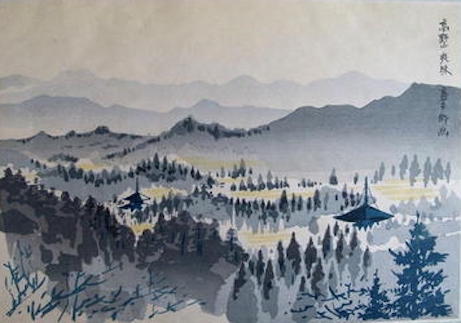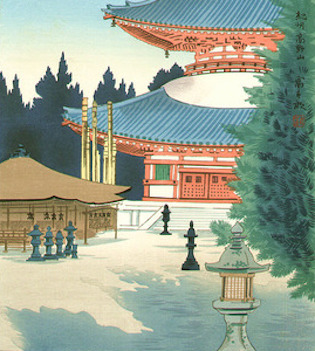Japan Art and Buddhism: Tokuriki Tomikichiro and Koyasan (Kukai)
Lee Jay Walker
Modern Tokyo Times

Tomikichiro Tokuriki (1902-1999) was born in the rich cultural city of Kyoto – and the prints in this article concern the Buddhist angle of Koyasan and the mountain backdrop.
Initially, Tokuriki focused on Nihonga art under the tutelage of Tsuchida Bakusen (1887-1936) and Yamamoto Shunkyo (1871-1933). However, under the guidance of Hiratsuka Un’ichi Unichi (1895-1997), he turned to printmaking.

The prints in this article all focus on Koyasan in Wakayama. Koyasan is the holy place of Shingon Buddhism and is internationally famous. Naturally, Koyasan is also a major internal spiritual and cultural tourist attraction in Japan.
The BBC reports, “In 816 AD, a monk named Kukai wandered into the thickly forested slopes of Mount Koya (Koya-san) in Japan’s Wakayama Prefecture in hope of finding a suitable site to build a base for his newly founded Shingon sect of Esoteric Buddhism. He chose an 800m-deep valley surrounded by eight peaks, whose ridges resemble the petals of an eight-petaled lotus blossom. Twelve centuries and 117 temples later, Kukai’s spiritual wooded wonderland is a [Unesco World Heritage site].”

Kukai (774-835), known as Kobo Daishi, established the first Buddhist monastery in the ninth century on Mount Koya (Koyasan). The Shingon sect holds a different thought pattern within the many schools of Buddhism in Japan – concerning the teachings of Kukai.
Hence, Kukai believed that enlightenment could be attained in one lifetime.

The Koyasan website (Shingon Buddhism) says, “The Shingon sect of Buddhism follows the doctrine of esoteric Shingon teachings compiled by Kobo Daishi (Kukai) in the Heian period. “Shingon” refers to the truth revealed by Buddhism. These teachings tell us that words and existence are inseparable, and that the true essence of Buddhism cannot be explained in human language. Instead, the words used in scripture embody the deep meaning and teachings found in phenomena around the world; they are signposts to true reality of all things. Kobo Daishi tells us that it is these esoteric teachings that are truth, and that esoteric Buddhism is the path to understanding them.”
Tokuriki lived in a notable part of Japan where Kyoto, Koyasan, Nara, and other places known for Buddhism and Shintoism are within easy reach of each other.

Modern Tokyo News is part of the Modern Tokyo Times group
http://moderntokyotimes.com Modern Tokyo Times – International News and Japan News
http://sawakoart.com – Sawako Utsumi and Modern Tokyo Times artist
https://moderntokyonews.com Modern Tokyo News – Tokyo News and International News
PLEASE JOIN ON TWITTER
https://twitter.com/MTT_News Modern Tokyo Times
PLEASE JOIN ON FACEBOOK